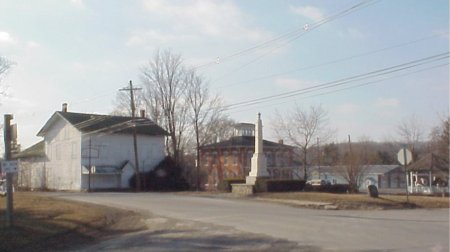|
|
 |
|
|||||||
 |
Postcard above of the Smithfield Hotel is from 1909.
The present day photo at left was taken by Joyce M. Tice February 2001. The old Baptist Church no longer stands, but the memorial, the house, and the building that was the hotel, remain. |
History of Bradford County, Pennsylvania with Biographical SketchesBy H. C. Bradsby, 1891 |
|
CHAPTER XLIV.
SMITHFIELD TOWNSHIP.
Page 488 - 489
THIS township is supposed to have been named for David Smith, who first purchased the title of the Connecticut Company. The surface is very broken ; several streams pass through the township emptying into Sugar and Towanda creeks. The township was setoff from Ulster in 1809. In 1814 it was divided into three equal parts, forming Smithfield, Springfield and Columbia. This same territory bad previously formed the townships of Smithfield, Murraysfield, and Cabot.
The first settler was a man named Grover, near what is now the Daniel Carpenter place, in 1792. Reuben Mitchell, who may be said to be the first permanent settler, came in 1794, and for the next four years himself and three members of his family were the total population of the township. He located just east of East Smithfield, and purchased David Smith's improvement; Mr. Mitchell left the country in 1840.
About 1798 several men, among them being Foster, Baldwin, Watterman, Wheeler, and a negro named "Caesar," came and made small improvements. James Satterlee came in 1799; located near East Smithfield. His wagon was the first that passed from Athens to Springfield; they were two days making the journey, a distance of ten miles' Col. Samuel Satterlee came in 1799, and settled three miles northwest of the village, afterward the Crittenden farm; he was an eminent soldier in the War of 1812, a member of the Legislature of Pennsylvania, and a very valuable citizen. Oliver Hayes also came in 1796; located on the Simon Mattison farm place. Michael Bird came from Boston in 1801, and undertook to make a living in the woods, farming. He had a severe experience; the entire family for some time made wooden brooms, which he carried on his back to the river. However, in time, he cleared and opened a fine farm, and eventually became a prominent citizen.
Jabez Gerould came in 1800, built a little log-cabin, raised a small patch, and in 1801 brought his family. The next year he was taken suddenly sick and died" leaving in the woods his widow and eight small children. The heroic little woman kept her family alive mostly by spinning flax, taking meal as payment. Phineas Pierce came from Vermont in 1800, and settled two miles northwest on the Edgar Wood farm. He enlisted in the War of 1812, and was killed near Niagara; his comrade from Smithfield was Joshua Ames; he died in the service. Col. Samuel Satterlee was in the same command; his wife, Eunice Pierce, was in Wyoming in July, 1778, an infant. She was carried across the mountains, sixty miles, to the Delaware river by her mother.
In 1800 Solomon Morse and Samuel Kellogg, both from Poultney, Vt., settled in the township; Kellogg was a Revolutionary soldier.
Nehemiah Tracy came in 1805; he was a, relative of United States, Senator Uriah Tracy, of Connecticut. John Bassett came in 1S06. In 1807 Noah Ford and Elihu Needham came from New York. In 1806 Alva Stocking and Alpheus Holcomb came to the township.
In 1809 Samuel Wood came from Vermont; he had ten sons and eleven daughters; nine of the sons came to Smithfield. The same year Ashael and John Scott came from Vermont. Judge Bullock gave the (late of John Scott's coming as 1803. between 1809 and IS11 Maj. Jared Phelps, Sloan Kingsbury, Isaac Ames, John -Phelps, David Titus, Abner W. Ormsby, Zephaniah Ames and Isaiah Kingsley, all came from Massachusetts, and settled the " Becket " neighborhood.
In 1813 Austin and Chauncey Kellogg came, their brother, Luman, following in 1816. David Forrest, a Revolutionary soldier, came in 1814. About the same time came also Stephen Wilcox, Rufus Halsey and Abner Thomas, all settling in the northwest part of the township.
In 1812 Asa Hacket came. In 1813 Asa Farnsworth and his family in 1814 William Farnsworth, Stephen Califf, Seth Gates, Daniel Forrant and Tartus Rose came with their families. In 1815 came Benjamin Hale, David Durfey Joseph Ames and Cyril Forman ; in 1816, Abraham Jones; in 1817, Asa Allen; in 1818, Joel Allen ; in 1819, Cromwell Childs, Edward A. Childs and Daniel Allen; in 1820, Geo. Thompkinson. A very worthy man, who had once been a Hessian soldier, Conrad Hartman, came to the township in 1816; he had been taken a prisoner at Trenton, and became an American citizen. Nehemiah Beech came in 1818.
The first sawmill was erected by Phineas Pierce, in 1806 ; the second was built by Mr. Tracy. The first gristmill was by Solo-mon Morse in 1808, about one-fourth of a mile west of the village. The first school-house was built in 180'1, a small log building, which answered for every purpose until 1818, when a frame was erected. Lyman Durfey opened the first store, in 1833, and soon after Shelden Trac y opened the second one. The first death was an infant child of Reuben Mitchell, who was also the first white child born.
The first church building (a log one) was put up in 1811, and used until 1861, when they built their present church ; pastor, Rev. John Bascom. In 1810 a Baptist Church was organized, and in 1819 a church building was put up. In 1821 a literary society was organized, chiefly by David Farnsworth, Ansel Scott, Harry Bird, Buckley Tracy, Darius Bullock and others.
East Smithfield is built on Maj. Phillips farm.
|